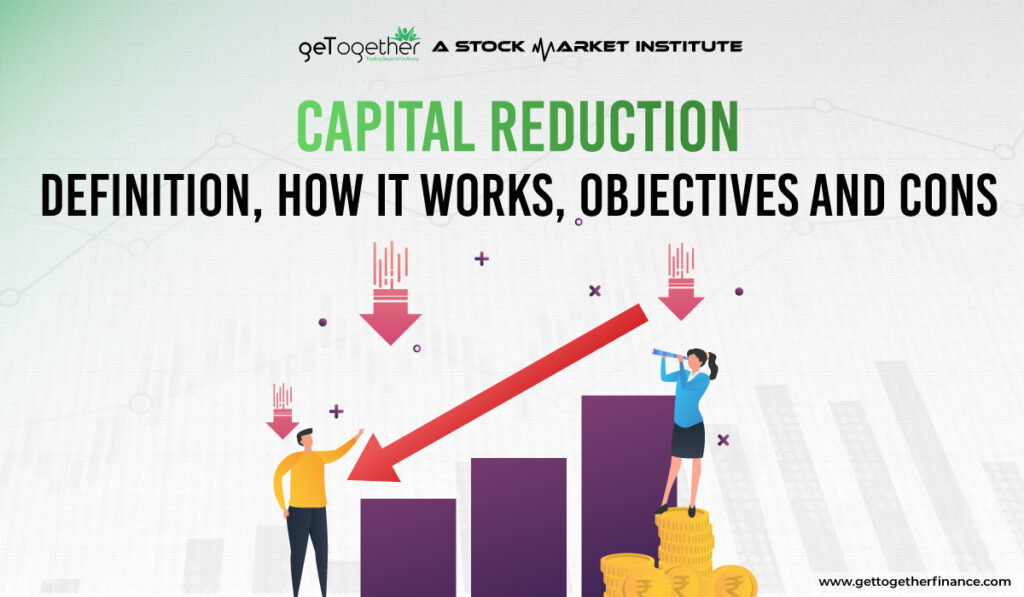Capital Reduction: Definition, How It Works, Objectives and Cons
- November 5, 2024
- 790 Views
- by Manaswi Agarwal


Have you ever thought about what happens when the company has excess funds or assets more than it needs for its operations? Here, capital reduction comes into the picture to restructure the finances of the company and reduce its share capital. The blog aims to spread light on the significance and functioning of reducing the capital.
What is Capital Reduction?
Capital Reduction is a financial strategic decision of reducing the nominal value of a company’s shares. The process of reducing a company’s share capital, the amount of money that has been raised from issuing shares to the public, is called capital reduction. It is a process carried out by the company to manage its finances and boost shareholder value. National Company Law Tribunal (NCLT) approves the execution of capital reduction by the company which is also governed by Section 66.
How does Capital Reduction work?

For this process, a company requires to fulfill legal and regulatory requirements. The company might involve court approval in case of creditors risk involvement. A company has to reflect the capital reduction process in its financial statements or accounting standards. The excess funds in a company can be mentioned as capital reserves in the balance sheet. There are several ways of capital reduction which a company can follow:
Reducing the share value
The nominal value of the share is reduced to cut the capital For example; the nominal value of share being Rs 20 is reduced to Rs 10.
Buying Back of Shares
In this method, the company buys back the shares from shareholders and cancels them which reduces the number of circulating shares in the market.
Reducing the Number of Shares
In this method, some shares are canceled to reduce the total number of issued shares with the purpose of management of excess capital.
Asset Distribution
The companies distribute its capital or liquid assets to the shareholders instead of maintaining them within the company itself.
Also Read: Net Asset Value
Effects of Capital Reduction

A company increases its efficiency of capital structure with the process of capital reduction. It enhances shareholders value and manages the finance by distributing the assets to the shareholders.
Efficient Capital Structure
Sometimes a company has excess resources like assets and cash than actually required for its operations. Therefore, this strategy helps to create an efficient capital structure and manage the resources in the best possible ways to restructure the balance sheet and make it more clean and appealing.
Enhance Shareholder Value
The shareholder value is increased through capital reduction as the number of outstanding shares is reduced or there is an increase in the earning per share. This makes the shares of the company more valuable to the investors.
The shareholders are largely impacted by the reduction in capital as it impacts the market value of remaining shares and also they might receive assets like cash or other, or nominal value of their share is decreased.
Return of Excess Capital to the Shareholders
If a company has excess funds or accumulated assets which are not required for future growth and operations of the company, the funds or assets can be used to return that excess capital to the shareholders.
Debt Repayment
During the times of financial uncertainties of a company, capital reduction can help it to repay the debts using free up funds.
Some other capital structure reasons to reduce the share capital of a company are as follows:
Improving Financial Ratios
The share capital is reduced to improve the financial ratios as well as fundamental indicators of a company like EPS, Return on Equity, book value, etc.
Avoid Excess Capitalization
It is done to avoid the condition of over capitalization which can have negative impact resulting in low returns, high costs and idle funds.
Eliminating Accumulated Losses
Capital Reduction can help the company to offset accumulated losses to represent a strong financial statement and be able to pay dividends in future. The losses of a company in financial statements shows its inefficiency in working which requires it to be set off to represent a strong financial position of the firm.
Limitations of Capital Reduction

A company might have several advantages by reducing its share capital, or decreasing the number of outstanding shares in the market but there are some drawbacks of this process that must be kept in mind before executing the process of capital reduction. Here are some of the limitations:
Legal Compliances
To undertake the process of capital reduction requires compliance with stringent legal and regulatory requirements. It is a long process which seeks approval of board of directors, shareholders, court approval and adheres to specific procedures.
Costly Process
Implementing a capital reduction procedure is quite costly as it involves legal fees, administrative fees, and several other costs for its proper execution.
Operational Disruptions
The whole process can be disruptive towards normal business operations and might divert the attention of manager and other employees from core business activities.
Tax Implications
Reducing the nominal value of shares is a legal and complex process which can have tax implications for shareholders as well as the company. The distribution of assets is subject to capital gain tax or other taxes leading to decrease in overall profits.
Buy Back and Capital Reduction

When a company purchases its own shares from the market and cancels them; this is called share buyback. In this, the company uses its cash reserves to repurchase the shares from the open market. Buying back results in reducing the number of outstanding shares which enhance EPS and value of remaining shares of the company.
On the other hand, capital reduction is to reduce the nominal value of its shares and canceling the shares from zero consolidation. The purpose of capital reduction is to reduce the tradable shares of the company while in shares buyback the shares are repurchased from the market. In capital reduction, the reduction is reflected in the financial statements where the funds are distributed to the shareholders.
In Short
To improve the capital structure of a company, when it has excess funds or assets, the company aims to reduce the share capital by reducing the nominal value of shares or by buying back shares which is called the process of capital reduction. The process is undertaken to enhance shareholders value by distributing the assets for reduction of share capital.
FAQs
What is Capital Reduction?
Capital reduction is the process of reducing the share capital of the company either by decreasing the nominal value of shares or by buying back the shares.
What is Buy Back Shares?
Buy back shares is a method of capital reduction wherein the company repurchases its shares from the open market to reduce the capital and decrease the number of outstanding shares in the market.
What is the Main Objective of Capital Reduction?
The main objective of capital reduction is to maintain the efficient capital structure of the company and increase shareholders value.
Is Capital Reduction Good or Bad?
Capital reduction is a good thing which is used for the simplification of a company’s capital structure. It increases shareholders value by distributing dividends to them.



 Instagram
Instagram 
